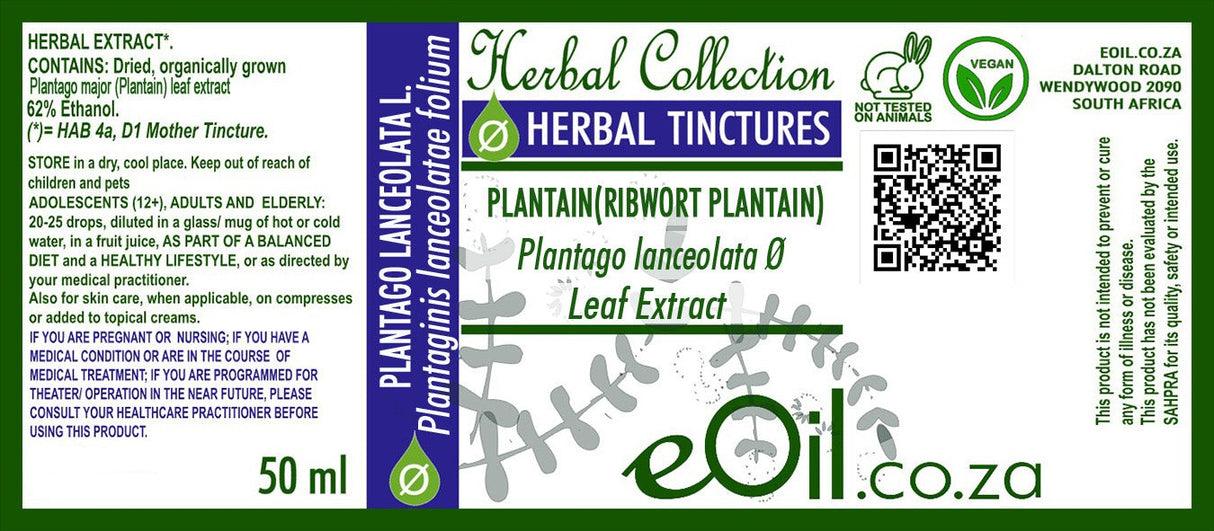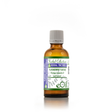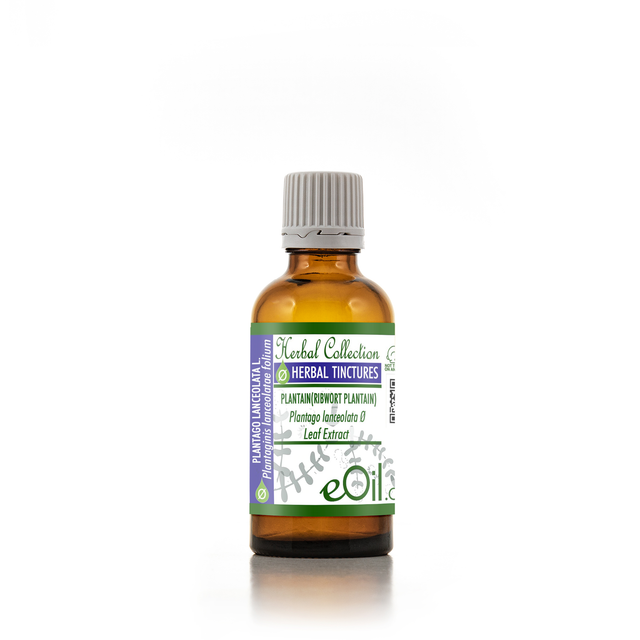Plantain - Liquid Herbal Extract
Plantain - Liquid Herbal Extract - 50 ML is backordered and will ship as soon as it is back in stock.
Description
Description
Understanding Mother Tinctures & Glycerines
Plantain liquid herbal extract tincture (Plantago major) is a pure, plant-based supplement valued for supporting skin, digestive, and respiratory wellness.
Naturally rich in bioactive compounds, this tincture is additive-free and suitable for daily wellness routines, herbal teas, or topical blends
IDENTIFICATION
CAS Number: 84929-43-1
EC Number: 284-526-5Plantago major is a perennial herb native to Europe and Asia, now naturalized worldwide. Its leaves have been used medicinally for centuries, particularly for wound healing and respiratory issues.
Traditional Uses
Plantago major tincture has been traditionally used to:
- Promote wound healing
- Soothe respiratory conditions
- Reduce inflammation
- Support digestive health
- Alleviate minor skin irritations
Active Compounds
The primary active compounds in Plantago major leaves include:
- Iridoid glycosides (aucubin, catalpol)
- Flavonoids (luteolin, apigenin)
- Polysaccharides
- Tannins
- Caffeic acid derivatives
Tincture Preparation
Plantago major tincture is typically prepared by macerating fresh or dried leaves in alcohol (usually 60% ethanol) for several weeks, then straining and bottling the resulting liquid.
Suggested Use
Internal Use: Take 2-4 ml (40-80 drops) of tincture diluted in water, 2-3 times daily.
External Use: Apply diluted tincture (1 part tincture to 3 parts water) to minor wounds or skin irritations.
Precautions and Contraindications
- Avoid use during pregnancy and breastfeeding due to insufficient safety data
- May interact with certain medications, including blood thinners and diabetes medications
- Discontinue use if allergic reactions occur
- Not recommended for children under 12 years old without professional guidance
Safety Considerations
While Plantago major has been used traditionally for various health concerns, it's important to note that high doses or prolonged use may cause side effects such as nausea, vomiting, or diarrhea.
Always consult with a qualified healthcare practitioner before using Plantago major tincture, especially if you have existing health conditions or are taking medications.
Traditional Wisdom Meets Modern Science
Plantago major has been used in traditional medicine systems worldwide for centuries.
Recent scientific studies have begun to validate some of its traditional uses, particularly in wound healing and anti-inflammatory applications.
However, more research is needed to fully understand its mechanisms of action and potential therapeutic benefits.
TRADITIONALLY USED FOR
Key Benefits
- Natural Soothing for Skin & Mucous Membranes: Traditionally used for skin health, plantain helps calm irritation, minor wounds, insect bites, burns, rashes, and promotes gentle tissue repair.
- Respiratory Tract Comfort: Useful for coughs, throat irritation, and as a demulcent in dry or ticklish coughs; soothes mucous membranes and reduces inflammation from allergies or minor infections.
- Digestive Relief: Gentle support for gastritis, reflux, mild ulcers, IBS, and gut lining integrity—soothes and protects sensitive digestive tracts.
- Anti-Inflammatory & Antioxidant: Contains bioactive compounds (aucubin, allantoin, mucilage) that support tissue healing and combat oxidative stress.
- Convenient Liquid Delivery: Fast-acting, more concentrated and portable than teas; suitable for travel, home, or office.
Dosage & Directions
- Adults: 1–2 ml (about 20–40 drops) in water or juice, 2–3x daily, or as directed by your practitioner.
- For acute skin/respiratory/gut support: Use up to 10 days at a time.
- Children (6+): Use half the adult dose under guidance.
- Not for pregnancy, infants, or after recent transplant/organ surgery except as prescribed.
Cautions & Contraindications
- Generally very well-tolerated; rare side effects (allergy, loose stools in sensitive users).
- Avoid if you have known allergies to Plantago species.
- Discontinue if rash, upset stomach, or allergic reaction appears.
Storage
- Store below 25°C, sealed, away from direct sunlight; keep out of children’s reach.
Plantain Tincture Recap Table
| Product Type | Main Benefits | Dosage & Use | Best For | Not For / Cautions |
|---|---|---|---|---|
| Tincture | Skin repair, mucous membrane soothing, gut calm, coughs, antioxidant | 1–2 ml (20–40 drops) in water or juice, 2–3x daily | Skin, gut, throat, allergy, travel kits | Pregnancy, infants, Plantago allergy |
Buy plantain tincture South Africa, Plantago major liquid extract, vegan skin healing drops, natural digestive and cough support, mucous membrane soothing botanical, herbal wound repair tincture.
INFORMATION
Source : http://www.wikiphyto.org/wiki/plantain
Reference on http://www.wikiphyto.org
Translation in English by Google Translate (go to the page of the source linked | on Chrome cellphones go on the 3 dots on the top right and select translate in your preferred language | on laptop right click your mouse and select option translate when hoovering on the page
plant name
Plantain, Hare's Ear , Five-seam Grass
International Latin denomination
Plantago major L.,
botanical family
Plantaginaceae
Description and habitat
- Perennial plants with leaves in a basal rosette, with convergent veins, oval for Plantago major , lanceolate for Plantago lanceolata
- Simple erect stems, dense cylindrical or ovoid flowering spikes of green flowers
- Wastelands all over Europe, North Africa, West Asia
History and tradition
- Etymology: its botanical name comes from the lation “planta” sole of the foot and “ago” I push, literally “grows under the soles of the feet” or “trampled underfoot”
- He seems to have settled in America after the arrival of the colonists. Native Americans would have named it "white feet" because it settled wherever the white man put his boot (its soles transported the tiny seeds from France or England)
Parts used
- Leaf, whole plant, juice
Dosage forms available
Usual dosages
Composition
Main components of the plant
- Mucilages (2 à 6,5 %) riches en D-galactose, L-arabinose : arabinogalactane, glucomannane, rhamnogalacturonane, rhamnoarabinogalactane
- Iridoids (2 to 3%): aucuboside , catalpol , asperuloside , globularin and derivatives
- Phenylethanoids : acteoside (= verbascoside 3 to 8%), isoacteoside , plantamajoside , lavandulifolioside
- Flavonoids : apigenin , luteolin and their derivatives
- Tannins (6.5%)
- Phenol acids : para-hydroxybenzoic acid , protocatechuic acid , gentisic acid , chlorogenic acid , caffeic acid , etc.
- Saponoside , silicic acid (>1%)
- Concentrates zinc carbonate
Main components of buds or young shoots
Main components of essential oil
Properties
Plant properties
- Anti-inflammatory ( apigenin ) and smooth muscle antispasmodic [1] , [2] , in airway conditions [3] , the anti-inflammatory properties may be due to an inhibition of nitric oxide NO production by macrophages [4] , analgesic
- Antiulcéreux [5]
- Antihistamine, inhibits mast cell degranulation [6] , [7]
- Phenylethanoids ( acteoside and plantamajoside ) inhibit 5-lipoxygenase in vitro
- Aucuboside and acids inhibit cyclo-oxygenase
- Intravenous administration induces the formation of interferon
- Antioxidant, inhibition of lipid peroxidation [8]
- Antitussive and mucolytic, inflammation of the upper airways ( mucilages , tannins )
- Antibacterial especially by the effect of the fresh plant ( aucuboside )
- Antiviral against Herpes virus [9] ( caffeic acid )
- Immunomodulating, increase in TNF alpha by polysaccharides [10] , and potentially anti-cancer [11]
- Hepatoprotective and cholesterol-lowering
- Uricosurique (aucuboside)
- Haemostatic, promotes healing, softening, antipruritic, local antihistamine
- Heat denatures beta-glucosidase which releases aucubigenin from aucuboside , prefer dosage forms which do not involve heat
Bud properties
Properties of essential oil
Indications
Indications of the whole plant (phytotherapy)
- Fistulas, ulcers, external hemorrhoids
- Insect bites (wasps, bees)
- Internal use: gastritis, peptic ulcers, diarrhoea, colitis
- Bronchitis and laryngitis, asthmatic cough, allergic rhinitis
- Hematuria
Indications of the bud (gemmotherapy)
Specific indications of essential oil (aromatherapy)
Known or suspected mode of action
- Emollient, protective role and water retention of mucilage (mucilaginous hydrocolloid)
- Role of iridoids ( catalpol ) and apigenin in anti-inflammatory activity
- Inhibition of PAF acether
- Apigenin blocks a step in the estrogen manufacturing chain
Usual formulations
Regulations
- French Pharmacopoeia list A (sheet)
- Activity recognized by the German Commission E ( Plantago major and Plantago lanceolata )
Possible side effects and precautions for use
Bibliographic references
- Go↑ Fleer H, Verspohl EJ. Antispasmodic activity of an extract from Plantago lanceolata L. and some isolated compounds. Phytomedicine. 2007 Jun;14(6):409-15. PMID 17298877
- Go↑ Murai M, Tamayama Y, Nishibe S. Phenylethanoids in the herb of Plantago lanceolata and inhibitory effect on arachidonic acid-induced mouse ear edema. Planta Med. 1995 Oct;61(5):479-80. PMID 7480214
- Go↑ Wegener T, Kraft K. Plantain (Plantago lanceolata L.): anti-inflammatory action in upper respiratory tract infections. Wien Med Wochenschr. 1999;149(8-10):211-6. PMID 10483683
- Go↑ Vigo E, Cepeda A, Gualillo O, Perez-Fernandez R. In-vitro anti-inflammatory activity of Pinus sylvestris and Plantago lanceolata extracts: effect on inducible NOS, COX-1, COX-2 and their products in J774A.1 murine macrophages. J Pharm Pharmacol. 2005 Mar;57(3):383-91. PMID 15807995
- Go↑ Samuelsen AB. The traditional uses, chemical constituents and biological activities of Plantago major L. A review. J Ethnopharmacol. 2000 Jul;71(1-2):1-21. PMID 10904143
- Go↑ Ikawati Z, Wahyuono S, Maeyama K. Screening of several Indonesian medicinal plants for their inhibitory effect on histamine release from RBL-2H3 cells. J Ethnopharmacol. 2001 May;75(2-3):249-56. PMID 11297859
- Go↑ Jong Phil Bak, Jong Bo Kim, Jong Hyuk Park, Yoon Jung Yang, In Su Kim, Eui Su Choung, Se Chan Kang. Screening and compound isolation from natural plants for anti-allergic activity. Journal of the Korean Society for Applied Biological Chemistry, June 2011, Volume 54, Issue 3, pp 367–375 https://doi.org/10.3839/jksabc.2011.058
- Go↑ Marina Gálvez, Carmen Martín-Cordero, Peter J. Houghton, María Jesús Ayuso. Antioxidant Activity of Methanol Extracts Obtained from Plantago Species J. Agric. Food Chem., 2005, 53 (6), pp 1927–1933
- Go↑ Chiang LC, Chiang W, Chang MY, Ng LT, Lin CC. Antiviral activity of Plantago major extracts and related compounds in vitro. Antiviral Res. 2002 Jul;55(1):53-62. PMID 12076751
- Go↑ Hetland G. Anti-infective action of immno-modulating polysaccharides (β-glucan and Plantago major L. pectin) against intracelllular (Mycobacteria sp. and extracellular (Streptococcus pneumoniae sp.) respiratory pathogens. Curr Med Chem Anti-Infective Agents 2003 ; 2: 135-146
- Go↑ Chiang LC, Chiang W, Chang MY, Lin CC. In vitro cytotoxic, antiviral and immunomodulatory effects of Plantago major and Plantago asiatica. Am J Chin Med. 2003;31(2):225-34. PMID 12856861
- Blumenthal M, Goldberg A, Brinckmann J (Ed). Expanded Commission E Monographs, American Botanical Council, Integrative Medicine Communications, 2000
- Schulz V, Hänsel R, Tyler VE. Rational Phytotherapy - A Physicians'Guide to Herbal Medicine, fourth edition, Springer, 2001, p. 181
- EMEA emea monograph
CAUTION
Store in a cool, dry place, away from light. Keep tightly closed, away from the reach of Children and pets.
Do not exceed the daily dose.
This product is not intended to prevent or cure any form of illness or disease.
If you are pregnant or nursing ; If you have a medical condition or are in the course of medical treatment ; If you are programmed for theater/operation in the near future, please consult your healthcare practitioner before using this product.
This product cannot replace a varied and balanced diet and a healthy lifestyle.
This product has not been evaluated by the SAHPRA for its quality, safety or intended use.
For More Information please check our General Safety Herbal products Page

Plantain - Liquid Herbal Extract - 50 ML is backordered and will ship as soon as it is back in stock.





